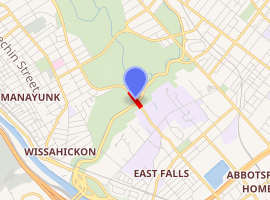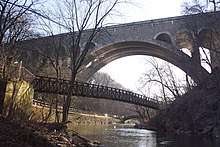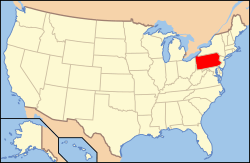Wissahickon Memorial Bridge
The Wissahickon Memorial Bridge, originally called and still also known as the Henry Avenue Bridge, is a stone and concrete bridge that carries Henry Avenue over Wissahickon Creek and Lincoln Drive in Fairmount Park in Philadelphia, Pennsylvania.
Wissahickon Memorial Bridge | |
|---|---|
 | |
| Coordinates | 40°01′26″N 75°11′46″W |
| Crosses | Wissahickon Creek |
| Locale | Philadelphia, Pennsylvania |
| Maintained by | City of Philadelphia |
| Characteristics | |
| Total length | 333 feet (101 m) |
| Width | 60 feet (18 m) |
| Height | 170 feet (52 m) |
| Longest span | 288 feet (88 m) |
| History | |
| Construction cost | $1,648,775 |
| Opened | May 1932 |
Wissahickon Memorial Bridge | |
   | |
| Location | Henry Avenue over Wissahickon Creek and Lincoln Drive Philadelphia, Pennsylvania |
| Coordinates | 40°1′27″N 75°11′46″W |
| Built | 1931 |
| Architect | Paul Philippe Cret, Ralph Modjeski |
| MPS | Highway Bridges Owned by the Commonwealth of Pennsylvania, Department of Transportation TR |
| NRHP reference No. | 88000807[1] |
| Added to NRHP | June 22, 1988 |

| |
It is a two-ribbed, open-spandrel, reinforced concrete arch bridge with one principal span. It was designed in 1927 by Paul Philippe Cret, a nationally acclaimed Philadelphia architect, in collaboration with Frank M. Masters, engineered by Ralph Modjeski and Clement E. Chase. It was completed in May 1932 at a cost of $1,648,775. It was designed to accommodate a lower deck, never constructed, to be used by trolleys or a subway extension to Roxborough.[2] Shortly after its completion, it was renamed the Wissahickon Memorial Bridge and was dedicated to the people of Philadelphia's northwest neighborhoods who served in World War I.

The bridge is 333 feet long, with a main span of 288 feet. Its 60-ft-wide roadway carries two lanes of traffic in each direction. The roadway is approximately 170 feet above the ground.[3] The bridge was repaved and repaired between 2008 and late 2010.
The bridge has been known as a suicide bridge since its opening. Beginning in 1941 for an unknown duration of time a policeman patrolled the span, questioning all pedestrians walking the bridge.[4]
It was listed on the National Register of Historic Places in 1988.
See also
References
- "National Register Information System". National Register of Historic Places. National Park Service. April 15, 2008.
- Gruen, J. Phillip (August 1997). "Henry Avenue Bridge" (PDF). Historic American Engineering Record. National Park Service. p. 11.
- "STATION POLICEMAN ON SUICIDE BRIDGE", Painesville Telegraph, December 6, 1941, accessed February 18, 2011.
External links
- Historic American Engineering Record (HAER) No. PA-464, "Henry Avenue Bridge"
- Chronology and images at Philadelphia Architects and Buildings

